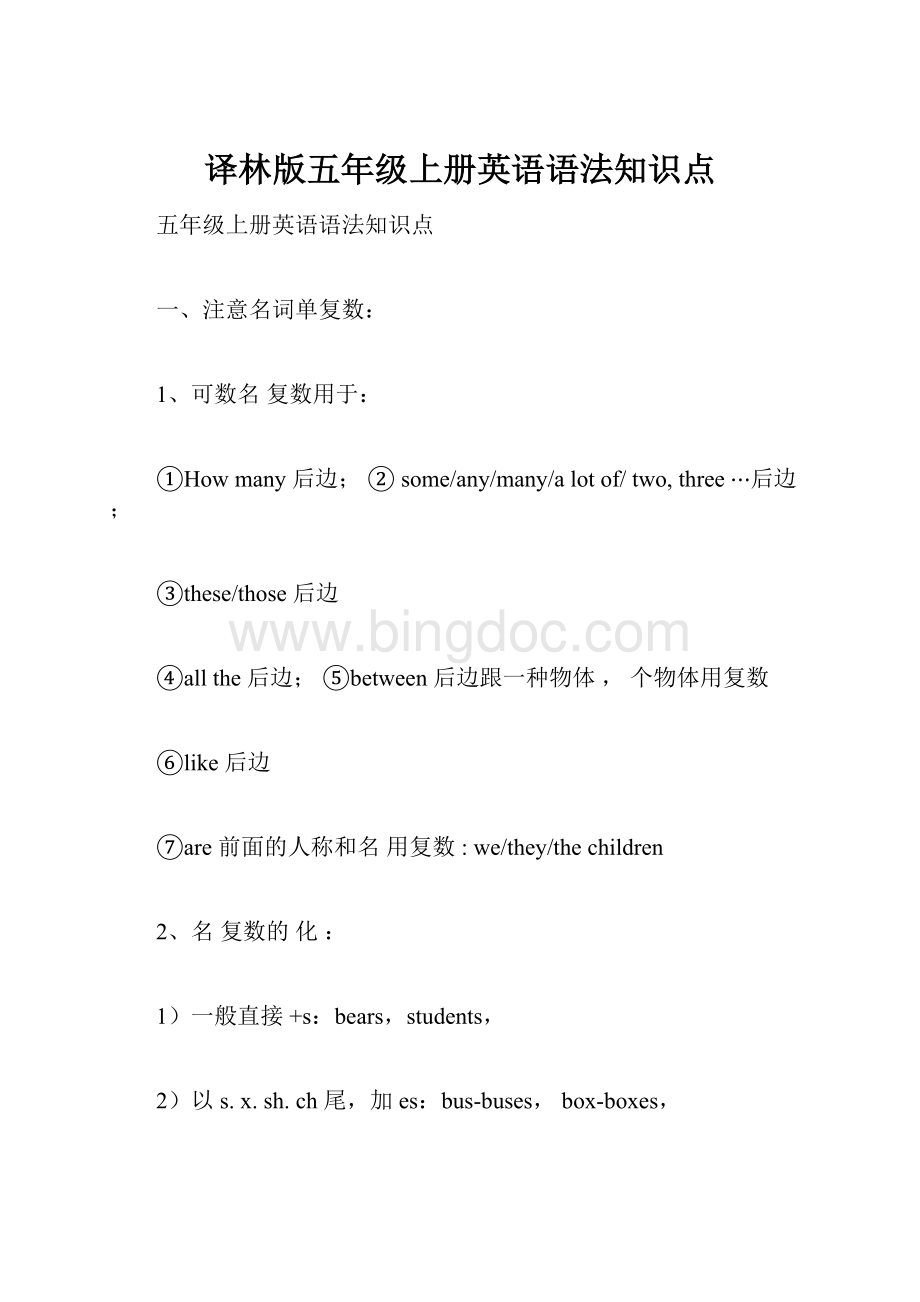译林版五年级上册英语语法知识点.docx
《译林版五年级上册英语语法知识点.docx》由会员分享,可在线阅读,更多相关《译林版五年级上册英语语法知识点.docx(34页珍藏版)》请在冰点文库上搜索。

译林版五年级上册英语语法知识点
五年级上册英语语法知识点
一、注意名词单复数:
1、可数名复数用于:
①Howmany后边;②some/any/many/alotof/two,three⋯后边;
③these/those后边
④allthe后边;⑤between后边跟一种物体,个物体用复数
⑥like后边
⑦are前面的人称和名用复数:
we/they/thechildren
2、名复数的化:
1)一般直接+s:
bears,students,
2)以s.x.sh.ch尾,加es:
bus-buses,box-boxes,
3)以“音字母+y”尾,把yi,再加ies:
library—librarieshobby---hobbiesstory---stories
4)不名复数:
man-men,woman-women,policeman-policemen,foot-feet,Child-children
3、不行数名:
water,soup,milk,juice,tea,coffee,bread(面包),rice(米),
hair等等。
二、注意一般在的第三人称数;(注:
全部否认句、疑句中,
都用原形。
)
1、一定句中哪些状况下用第三人称数:
(俗称:
三单)
1)人称代词he,she,it作主语时;
2)单个人名、地名或称号作主语时;
3)单数可数名词或"this/that/the+单数可数名词"作主语时;
4)不行数名词作主语时;5、当数字或字母作主语时,等等。
2、动词第三人称单数变化规则以下:
1)一般状况下,动词后边直接加s.如:
works/plays/reads
2)以s.x.sh.ch或o结尾的动词,在后边加es.
例:
teach-teaches,watch-watches,do-does,go-goes
3)以辅音字母+y结尾的动词,把y变成i,再加es.
例:
study-studiesfly-fliescarry-carries
4)不规则动词的第三人称单数:
have—has;be—is
三、人称代词、名词全部格及序数词
单数
复数
一
二
三
一
二
三
主格
I
you
he
she
It
we
you
they
宾格
me
you
him
her
It
us
you
them
物主
my
your
his
her
Its
our
your
their
代词
我的
你的
他的
她的
它的
我们的
你们的
他们的
1、主格用来作句中的主语,用于动词前面。
例:
Theyaredoctors.
2、宾格用来作句中的宾语,放在动词或介词的后边。
本册书上出现的词
组:
infrontofhershowheraroundpushmeteachyouWhat’swrongwithhim
writehimaletter
Here’asChristmascardforyou.Letme⋯.chatwiththemontheInternet
giveitacake
3、形容词性物主代词+名词
形容词性物主代词,之因此叫它们形容词是由于他们一定放在名词前面。
4、名词全部格作形容词性,表示所属关系;在人名或称号后加’s,以s
结尾的,直接加’。
如:
mother’s,parents’
5、序数词first---second---third---fourth1)序数词一般要与the连用;2)在某一层
楼用介词on。
四、选择和用所给词适合形式填空
1、哪些状况加动词原形(注:
有to时,to跟后边的动词原形放在同
一空格)
1)wantto+动词原形2)wouldliketo+动词原形3)it’stime
to+动词原形
4)神态动词can+动词原形5)助动词(do,does,don’t,doesn’t)+动
词原形
6)let+动词原形7)祈使句中动词用原形(如Doyour
homework,please.)
8)否认句在句首加Don’t(如Don’tdoyourhomework,please)+动词原
形
2、哪些状况加动词ing
1)like2)go3)begoodat4)be5)后边跟名词,如swimming
lesson
动词+ing变化规则以下:
A、直接加上ing:
draw-drawingplay-playingread-reading
B、以不发音的e结尾,去e加上ing
skate-skatingmake-makingdance-dancing
have-havingcome-comingwrite-writing
C、以重读闭音节结尾的单词要双写尾字母,再加上ing
从单词的末端开始往前数切合“辅音-元音-辅音”构造的。
(注:
词尾是w和y的除外,如:
drawing,playing等除外);
run-runningsit-sittingput-puttingchat-chatting
get-gettingswim-swimmingstop-stopping
shop-shopping
3.形容词加名词(形名)
如:
abeautifulgirl
4.动词加副词(动副)
如:
swimwell
5.Some和
any
用法:
“some”一般用于一定句,“any”用于否认句和疑问句。
但在一些表示委
婉求,想获得方一定回答也用“some”。
(小技巧:
末端是句号,句
中是any,那句型能否认句)
6.Therebe构就近原,be的取决于跟在后边的名数
量。
如:
Thereisateacherandsomestudentsintheclassroom.
7.器前加the,球前不加the.如:
playthepiano,playfootball
8.Who看作特别的第三人称数(Whosingswell)
9.一般在组成:
1)主+be(am,is,are)+其余。
2)主+行+其余。
关:
always,usually,often,sometimes,onSundays,every⋯
(注:
主第三人称数,加s,es或音+y,把yi再加es;其余
时候动词用原形)
10.在行关:
look,listen,now(注:
be(isamare)+ing,两
者缺一不行)
11.and前后一致。
指当句子中有两个或两个以上的共用同一个主,一般的保持一致。
Sheoftengoesfishingandtakesphotos.Let’sgoandhavesomechicken.
12、同样意思不一样用法的辨析:
1)有;thereis/are和have/has
thereis/are表示在某地有某物(或某人);表示存在;therebe就近原;
have/has表示某人有某物;表示所属关系;前面必有主。
2)也;too-either-also
too用于一定句和疑句句末;either用于否认句句末;also用于句中。
3)都;both-all
both用于二者都;all用于三者及以上都。
4)好;good-well
good+名;+well。
5)和;with-and
with是介,意思是“和⋯⋯一同”,后边跟名或代的格。
and是,意思是“和”,用and接两个数名或代作主,
用复数。
五、句型
①同句:
1.It’stimeforsth=It’stimetodosth.是⋯了(注:
for后边跟名;to
后边跟原形)
It’stimefordinner.=It’stimetohavedinner.
2.Whattimeisit=What’sthetime几点呢
3.Thereis(are)no⋯(s)⋯=Thereisn’t/arent’any⋯没有⋯
4.haveno⋯=don’thave(any)没有⋯
Theyhavenolegsorarms.=Theydon’thaveanylegsorarms.
5.hasno=doesnhave’t(any)没有⋯
6.Ilikepicnics.=Ilikehavingpicnics.{注:
like后边跟名复数或名(+ing)}
7.
showsth(某物)tosb(某人)=showsb(某物)sth(某人)向⋯展现⋯西
8.
givesth(某物)tosb(某人)=givesb(某物)sth(某人)
⋯人⋯西
9.
Whatalovelyant!
=Howlovelytheantis!
多么可的啊
10.ThatisJan’umbrellas.=ThatumbrellaisJan’s.那是杰的
11.What’swrongwithhim=What’sthematterwithhim他怎么了
②否认句
1、有be(am,is,are),be后直接加not(amnot/isnot=isn’t/arenot
=aren’t);
2、有can,can后直接加not(cannot=can’t);
3、只有,在原形前加don’t;三前加doesn’t,回原
形。
Hedoeshishomework.(改成否认句)Hedoesn’tdohishomework.
③一般疑句:
用Yes或No回答的句子
1、有be,be提早;
2、有can或would,can或would提早;
3、只有,句首加Do/Does,用原形;
注意:
I’m变Areyou;some变any;my变your;and变or.
④特别疑问句:
有特别疑问词+一般疑问句
Therebe句型发问:
1、对数目发问:
1)Howmany+名词复数+arethere+介词短语
(注:
对therebe后边可数名词的数目发问时,不论主语是单数仍是复数,都
用复数形式发问)
例:
Thereare24classroomsinourschool/Thereonlyisoneclassroominourschool对划(
线部分发问)
Howmanyclassroomsarethereinourschool(注:
上边两句发问,都是这
句子)
2)Howmuch+不行数名词+isthere+介词短语
例:
Thereissomemilkintheglass.(对划线部分发问)Howmuchmilkisthereintheglass
2、对主语发问
therebe针对主语发问的特别疑问句的基本构造是:
What’+s介词短语
(注:
对therebe后边的主语发问时,不论主语是单数仍是复数,都用
What’s发问)
例:
Therearesixbooksonthedesk./Thereisabookonthedesk.(对划线部
分发问)
What’sonthedesk(注:
上边两句发问,都是这句子)
⑤叹息句的构造:
叹息句常用how或what来指引
(1)what指引的叹息句,最后修饰的是名词
(2)how指引的叹息句,最后修饰的是形容词/副词
Whatalovelyant!
=Howlovelytheantis!
多么可爱的蚂蚁啊!
对划线发问,疑问词:
What问什么;Whatcolour问颜色;Whattime问详细时间(如几点钟);when问范围广的时间;where问在哪里;Howold问年纪;howmany问数目(可数名词);
howmuch1)问数目(不行数名词),2)问价格;howabout问如何;who问谁(人);whose问谁的东西(问主人);同音词:
B—be—bee,C—see—sea,R—are,T—tea,U—you,Y—why,I-eye,
too-two-to,four—for,here—hear,there—their,right—write,sun—son,no—know,pair—pear,it’s—its,buy—by—bye,hi—high,wear—where,aren’taunt,—who’s—whose,
近义词(或同义词):
Many—lotsof—alotof,desk—table,like—love,tall—high
near—beside,
too—also,
listen—hear,
look—see,
class—lesson,
glass—cup,
home—house,
beautiful—pretty,
usually
—often,
hi—hello,
speak—say—talk,river—lake,
wouldlike—want,gohome—comehome
反义词(或对应词):
yes—no,this—that,these—those,here—there,go—come,open—close,
big—small,
fat—thin,tall—short,
long—short,
black—white,
happy—sad,
hot—cold,cool—warm,
soft—hard,
on—under,in
frontof—behind,
in—out,boy—girl,man—woman,
wrong—right,
down—up,sit—stand,easy—difficult,
takeoff(脱下)—puton(穿上)
完好形式:
I’m—Iam,
we’re—weare,
you’re—youare,
he’s—heis,
it’s—itis,
there’s—there
is,
isn’t—isnot
who’s—whois,
Let’s—letus,
I’d—Iwould,
can’t—cannot,
don’t—donot,
doesn’t—doesnot
特别的名词复数:
man—men,woman—women,policeman—policemen,child—children,
foot—feet,
fish—fish,people—people,Chinese-Chinese
三单动词变化:
特别的:
do---does;go--goes;have--has;teach—teaches;
watch--watches
;
wash--washes;
push--pushes
;
brush--brushes;
catch--catches;study--studies;fly--flies;
其余的直接加
s.
动词变名词
:
A.一般状况下在动词后边直接加er。
teach-teacher,work—worker,play—player,sing—singer,find
—finder
B.以e结尾的动词直接加r。
write—writer,drive—driver,come—comer,dance—dancerC.切合重读闭音节的动词,先双写最后一个字母,再加er。
run—runner,begin—beginner,swim—swimmer
D.部分单词在词尾加or。
visit—visitor,act—actor
E.自己既是动词又是名词。
cook—cook,doctor—doctor
Culture板块:
U1,U2,U3,U5,U6,
U7.
1).U1:
CoffeeispopularinWesterncountries.
TeaispopularinChina.
咖啡在西方国家受欢迎。
茶在中国受欢迎。
2).U2:
IntheUK,thisisthegroundfloor.
IntheUS,thisisthefirst
floor.
在英国,这是一楼。
在美国,这是一楼。
3).U3:
YoucanseepandasinChina.
Youcanseebaldeaglesin
theUS.
你在中国能够看到熊猫。
你在美国能看到秃鹰。
YoucanseepolarbearsinCanada.
Australia.
Youcanseekangaroosin
你在加拿大能看到北极熊。
你在澳大利亚能看到袋
鼠。
4).U5:
IntheUS,wecallapolicemana
“cop”.IntheUK,wecalla
firefightera
“fireman
”.
在美国,我们称号警察为
cop。
在英国,我们称号消防队
员为
fireman。
5).U6:
WewriteChineseaddresseslikethis.我们这样书写中文地点。
(国名—地名—人名,由大到小)
WewriteEnglishaddresseslikethis.我们这样书写英文地点。
(人名—地名—国名,由小到大)
6).U7:
BasketballisverypopularintheUS.
Footballisverypopularin
theUK.
篮球在美国很受欢迎。
足球在英国很受欢迎。
TabletennisisverypopularinChina.
乒乓球在中国很受欢迎。
看国旗写国家名:
(U6)
UKAustralia
China
Canada____US
Soundtime:
U1:
U2:
U3:
U4:
U5:
U6:
U7:
U8:
U4Songtime:
U8Songtime: